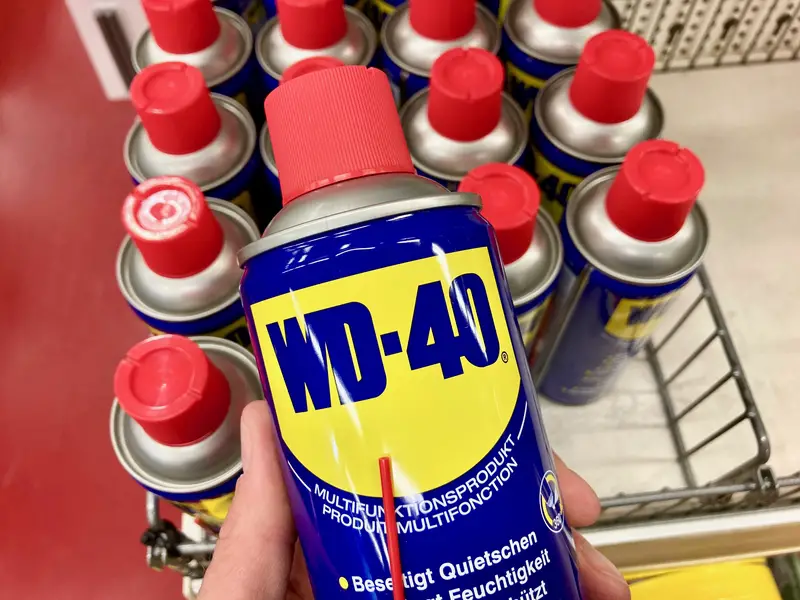That trusty blue and yellow can of WD-40 sitting in your garage might seem like the ultimate fix-all solution, but using it wrong could create serious problems. While millions of people reach for this popular spray to tackle squeaky hinges and stuck bolts, many are unknowingly making mistakes that can damage their belongings, create safety hazards, or even put their family at risk. The truth is, WD-40 isn’t always the right tool for the job, and some common applications can backfire spectacularly.
Using WD-40 near flames or heat sources
WD-40 is extremely flammable, yet many people casually spray it without thinking about nearby heat sources. The vapors are heavier than air and can travel along surfaces to reach flames or ignition sources well beyond your immediate work area. This means that pilot light on your water heater, that lit candle on the windowsill, or even a cigarette could ignite vapors and cause flames to flash back along the vapor trail to you.
Even seemingly harmless heat sources pose risks when WD-40 is involved. Space heaters, gas stoves, and hot exhaust pipes can all ignite the spray or its lingering vapors. The cans themselves become dangerous when exposed to temperatures over 120°F, potentially exploding if punctured or burned. Always ensure complete ventilation and keep all heat sources away from your work area when using this penetrating oil to avoid turning a simple repair into a dangerous situation.
Spraying WD-40 on car battery terminals
Car batteries produce sparks and electrical current, making them extremely dangerous places to use flammable WD-40. Many people think spraying it on corroded battery terminals will clean them up, but this creates a perfect storm for disaster. A single spark from a loose connection or the battery itself can instantly ignite the vapors, causing an explosion right next to your face and hands.
The same principle applies to household electrical panels and circuit breakers. Never attempt to lubricate electrical components with WD-40, no matter how squeaky or stiff they seem. Instead, use non-flammable electrical contact cleaners or dielectric grease specifically designed for electrical work. These specialized cleaners won’t create fire hazards and are formulated to work safely around electrical components without risking your safety or your property.
Applying WD-40 to certain plastic materials
Not all plastics react well to WD-40’s petroleum-based formula. Polycarbonate and clear polystyrene plastics can crack, craze, or completely break apart when exposed to the spray. These materials are commonly found in safety glasses, window glazing, some refrigerator components, and many 3D-printed objects. The hydrocarbon ingredients in WD-40 cause these plastics to weaken over time, even if damage isn’t immediately visible.
The tricky part is identifying which plastics are safe and which aren’t. Materials like polyethylene, polypropylene, and vinyl can handle WD-40 exposure without problems, but unless you’re certain about the plastic type, it’s better to avoid using the spray altogether. When in doubt, test a small, hidden area first or choose a silicone-based lubricant that’s gentler on plastic materials and won’t cause long-term damage to your belongings.
Using WD-40 on bike chains without proper cleanup
While WD-40 can clean a dirty bike chain, using regular WD-40 as a permanent lubricant creates more problems than it solves. The spray acts as both a cleaner and lubricant, but during the cleaning process, it removes existing lubricant from the chain. This leaves the chain with inadequate lubrication, potentially creating more friction than before you started. Additionally, the overspray can reach your brake components, creating a serious safety hazard.
If you do use WD-40 to clean your bike chain, you must follow up with proper chain lubricant designed specifically for bicycles. The company makes specialized bike chain lubricants that provide long-lasting protection without the cleaning action that strips away essential lubrication. Wipe away excess product and avoid getting any spray on your brake rotors or pads, as this could compromise your ability to stop safely.
Forgetting to wear protection during extended use
Quick sprays here and there might not require special equipment, but extended WD-40 use can cause health problems if you don’t protect yourself. Breathing in too much of the substance can cause nausea, dizziness, and respiratory irritation. Some people experience skin reactions including rashes, burning, or itching sensations when the product contacts their skin for extended periods.
For longer projects, simple protection makes a huge difference. A basic KN95 face mask helps prevent inhaling vapors, while long sleeves and work gloves protect your skin from direct contact. These precautions become especially important when working in poorly ventilated areas where vapors can accumulate. The manufacturer recommends these safety measures for extended use, so don’t skip them when tackling bigger projects around your home.
Allowing pets access to treated surfaces
Pets can’t understand warnings about avoiding freshly sprayed surfaces, making WD-40 particularly dangerous around curious cats and dogs. If pets lick treated surfaces or get the product on their paws and then groom themselves, they risk ingesting petroleum-based chemicals. This can cause digestive problems, but the real danger comes from aspiration – when the liquid enters their airway instead of their stomach.
Aspiration of WD-40 can cause chemical pneumonia, severe lung damage, or even death in pets. Keep animals away from any areas where you’ve used WD-40 until surfaces are completely dry and odor-free. Store the product securely where pets can’t access it, and if you suspect your pet has ingested any amount, contact your veterinarian immediately. Consider using pet-safe lubricants for repairs in areas where your animals spend time.
Spraying WD-40 near food preparation areas
Kitchen repairs often seem like perfect opportunities to use WD-40, but the product isn’t food-safe and can contaminate cooking surfaces. Even small amounts can cause nausea, vomiting, and gastrointestinal irritation if ingested. The bigger concern is that WD-40 poses an aspiration risk – if it enters your airway instead of your digestive system, it can be potentially fatal.
If you must use WD-40 in kitchen areas, keep it far away from food preparation surfaces and clean thoroughly afterward. Wipe down all nearby surfaces that could have been affected by overspray, and wash your hands completely before handling food. For kitchen applications, consider food-grade alternatives like food-grade silicone spray that won’t pose contamination risks to your family’s meals and cooking areas.
Using regular WD-40 on door hinges long-term
Door hinges seem like obvious candidates for WD-40, and the spray will temporarily quiet squeaks. However, regular WD-40 doesn’t provide long-lasting lubrication for hinges that see daily use. The petroleum base can attract dirt and dust over time, potentially making the hinge problem worse than before. What starts as a quick fix often becomes a recurring maintenance headache.
For lasting results on door hinges, clean the area first, then use a dedicated lubricant designed for the job. White lithium grease provides superior long-term protection and won’t attract contaminants like regular WD-40 can. The company also makes specialized dry lubricants that resist dirt accumulation. These purpose-made lubricants cost slightly more but eliminate the need for frequent reapplication and provide better protection for your hardware.
Applying WD-40 to dirty or contaminated surfaces
Many people spray WD-40 directly onto dirty, greasy, or contaminated surfaces expecting it to clean and lubricate simultaneously. While WD-40 has some cleaning properties, it works best when applied to clean, dry surfaces. Spraying over existing dirt and grime prevents the product from reaching the actual surface that needs treatment, reducing its effectiveness significantly.
Take time to clean surfaces before applying WD-40 for best results. Use a dry cloth for light dust, or a damp cloth followed by thorough drying for heavier contamination. For built-up grime in tight spaces, compressed air can blast away debris before lubrication. This extra step ensures the WD-40 contacts the surface directly, providing better penetration and longer-lasting results than simply spraying over existing dirt and hoping for the best.
Understanding these common WD-40 mistakes can save you from costly repairs, safety hazards, and frustrating repeat problems. While this versatile spray has many legitimate uses, knowing when and how to use it properly makes all the difference. Take a moment to consider safety, choose the right product for each specific job, and prep surfaces properly for the best results.

